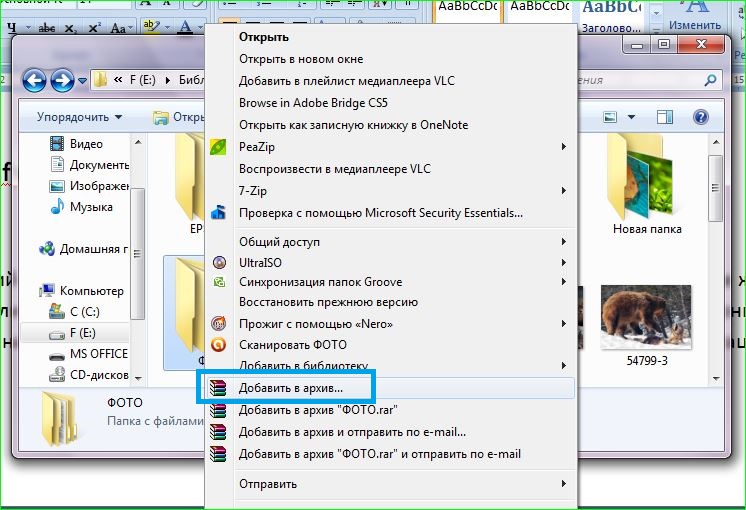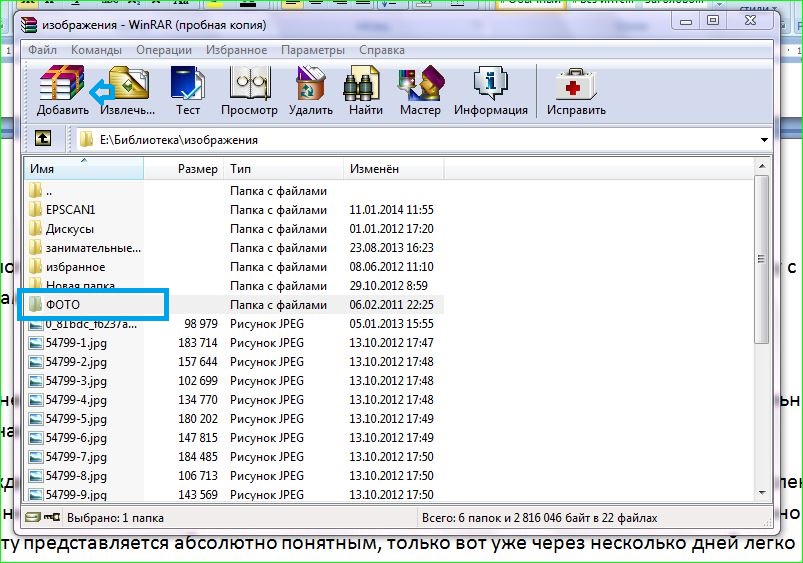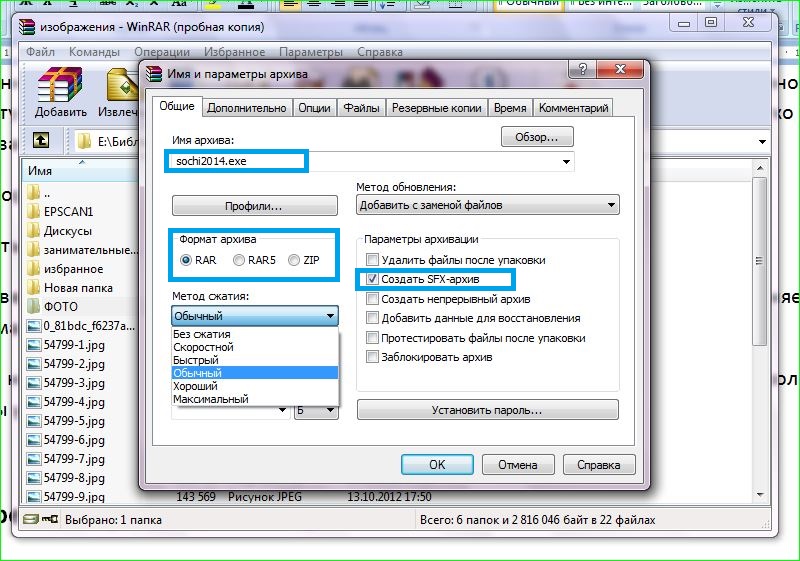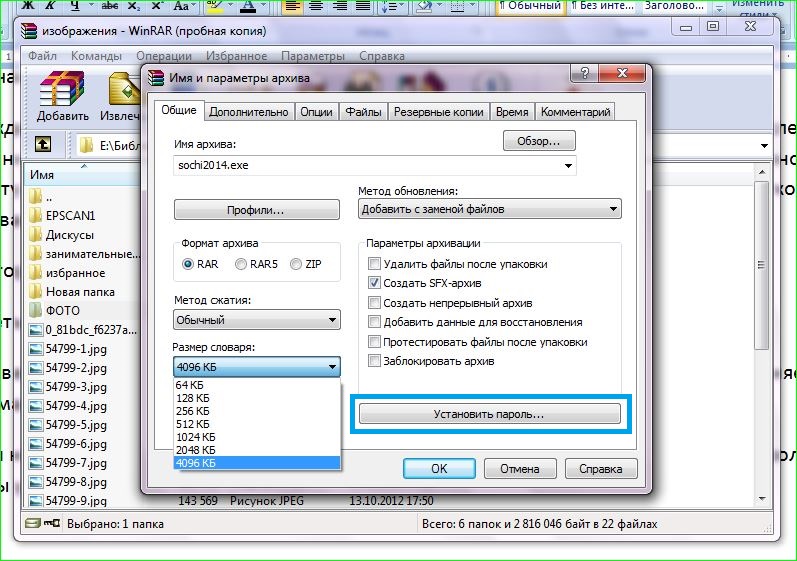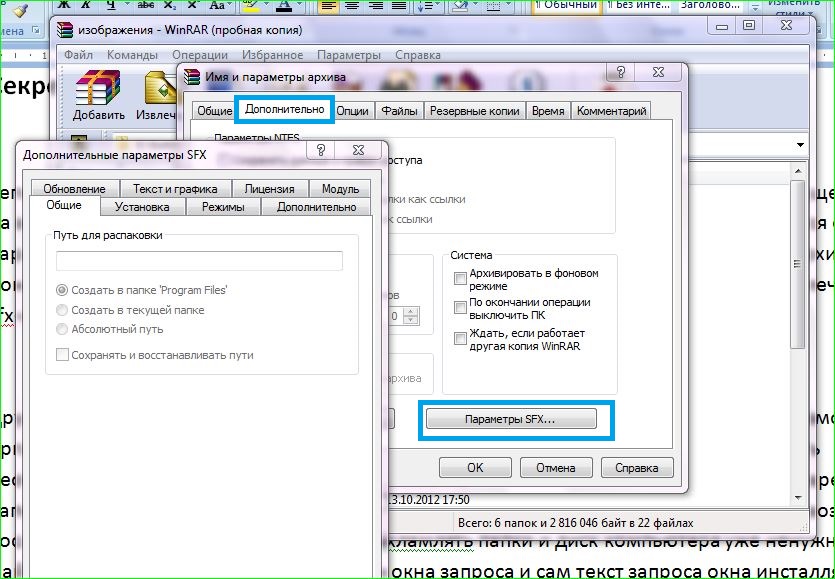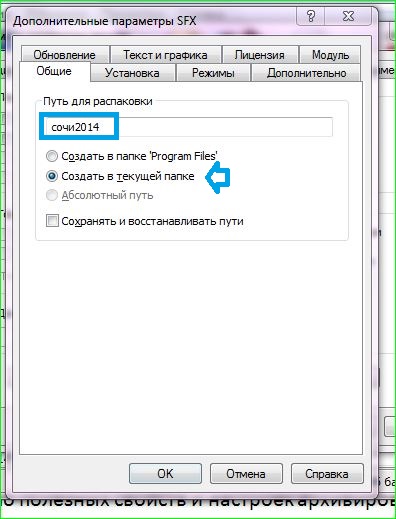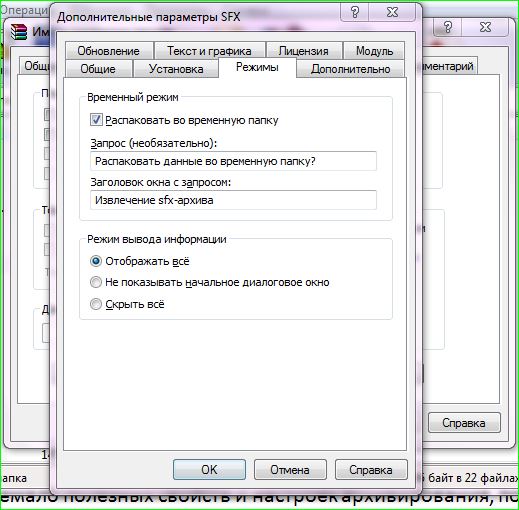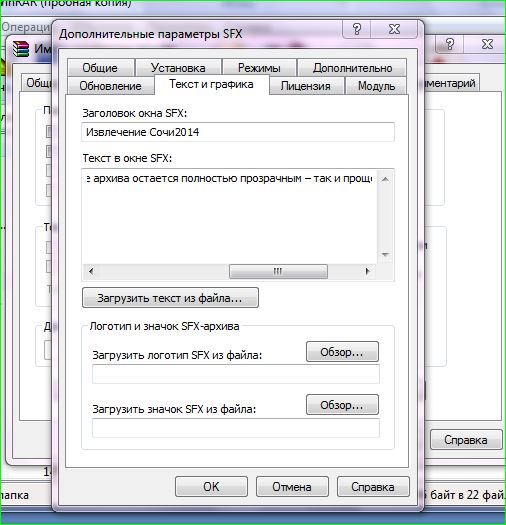- Главная
- Песочница
- Общий форум
- SFX создание и работа.

|
Команды для сценариев SFX, с описаниями;!@Install@!UTF-8! — Начало сценария. Возможные комбинации и скриншот функцииGUIMode=»1″ — вкл. прогресс бар во время распаковки (неактивна кнопка закрытия). — Возможные комбинацииOverwriteMode=»2+8″ — рекомендуемое значение!, можно вместо «2+8» писать «10» (без разницы). — Скриншот функции— Скриншот функции— Возможные комбинацииRunProgram=»»файл.exe«» — запуск указанного файла, после распаковки. — Возможные комбинации с справкойD — Создать ярлык на Рабочем столе Shortcut=»Du,{%%T\файл.exe}» — создать ярлык на рабочем столе (если нужно в другом месте, меняем с буквы D на S или P или T). — Возможные комбинацииDelete=»%%T» — удалить папку с расспакованными файлами, при закрытии запущенного файла/программы. — — Небольшой список системных переменных, считываемых модулем SFX%ALLUSERSPROFILE% — Модульные переменные%%M — имя SFX архива без пути — Последний раз редактировалось: KaSpieC 666 (2016-03-18 06:54), всего редактировалось 27 раз(а) |
![Ответить с цитатой [Цитировать]](data:image/svg+xml,%3Csvg%20xmlns='http://www.w3.org/2000/svg'%20viewBox='0%200%200%200'%3E%3C/svg%3E)
 Отправлено: 09-Мар-2016 05:10
Отправлено: 09-Мар-2016 05:10
(спустя 1 час 2 минуты)

(спустя 1 час 2 минуты)
KaSpieC 666 |
Последний раз редактировалось: KaSpieC 666 (2016-03-11 22:14), всего редактировалось 2 раз(а) |
![Ответить с цитатой [Цитировать]](data:image/svg+xml,%3Csvg%20xmlns='http://www.w3.org/2000/svg'%20viewBox='0%200%200%200'%3E%3C/svg%3E)
 Отправлено: 09-Мар-2016 22:06
Отправлено: 09-Мар-2016 22:06
(спустя 16 часов)

(спустя 16 часов)
SergeyZV |
20933
Не пробовал, но логика подсказывает Не лучшый метод, т.к. в диспетчере задач висят сразу 2 процесса ProgramName_%%P.exe и ProgramName.exe. RunProgram=»hidcon:x64:cmd.exe /c (del /q ProgramName.exe & rename ProgramName64.exe ProgramName.exe)» Так предпочтительнее. |
![Ответить с цитатой [Цитировать]](data:image/svg+xml,%3Csvg%20xmlns='http://www.w3.org/2000/svg'%20viewBox='0%200%200%200'%3E%3C/svg%3E)
 Отправлено: 09-Мар-2016 22:25
Отправлено: 09-Мар-2016 22:25
(спустя 18 минут)

(спустя 18 минут)
SunOK |
RunProgram=»hidcon:cmd.exe /c start ProgramName.exe» %SFX%.exe как бы отработал и может не подчистить после себя ТЕМП. Зато можно вынимать носитель с SFX-архивом. |
![Ответить с цитатой [Цитировать]](data:image/svg+xml,%3Csvg%20xmlns='http://www.w3.org/2000/svg'%20viewBox='0%200%200%200'%3E%3C/svg%3E)
 Отправлено: 09-Мар-2016 22:30
Отправлено: 09-Мар-2016 22:30
(спустя 5 минут)

(спустя 5 минут)
SergeyZV |
%SFX%.exe как бы отработал и может не подчистить после себя ТЕМП. Зато можно вынимать носитель с SFX-архивом. Не спорю. Есть ньюансы. |
![Ответить с цитатой [Цитировать]](data:image/svg+xml,%3Csvg%20xmlns='http://www.w3.org/2000/svg'%20viewBox='0%200%200%200'%3E%3C/svg%3E)
 Отправлено: 09-Мар-2016 22:34
Отправлено: 09-Мар-2016 22:34
(спустя 3 минуты)

(спустя 3 минуты)
KaSpieC 666 |
|
![Ответить с цитатой [Цитировать]](data:image/svg+xml,%3Csvg%20xmlns='http://www.w3.org/2000/svg'%20viewBox='0%200%200%200'%3E%3C/svg%3E)
 Отправлено: 09-Мар-2016 22:47
Отправлено: 09-Мар-2016 22:47
(спустя 13 минут)

(спустя 13 минут)
SunOK |
RunProgram=»hidcon:%%P:ProgramName_%%P.exe» Тоесть теоретически RunProgram=»hidcon:%%P:cmd.exe /c start «» «%%Tфайл%%P.exe»» правда не знаю нужно ли после хидкона переменная, если на обычной ОС запускать. |
![Ответить с цитатой [Цитировать]](data:image/svg+xml,%3Csvg%20xmlns='http://www.w3.org/2000/svg'%20viewBox='0%200%200%200'%3E%3C/svg%3E)
 Отправлено: 09-Мар-2016 23:20
Отправлено: 09-Мар-2016 23:20
(спустя 32 минуты)

(спустя 32 минуты)
SunOK |
;!@Install@!UTF-8:x86! hidcon в данном случае параметр. В контексте WinPE, в которой отсутствует подсистема х86, возникает вопрос: придется сразу делать с SFX-модулем х64 и тогда эта самораспаковка не запустится на 32-разрядной ОС? Тогда нет смысла в дополнительных секциях, пишем сразу конфиг х64. |
![Ответить с цитатой [Цитировать]](data:image/svg+xml,%3Csvg%20xmlns='http://www.w3.org/2000/svg'%20viewBox='0%200%200%200'%3E%3C/svg%3E)
 Отправлено: 10-Мар-2016 19:43
Отправлено: 10-Мар-2016 19:43
(спустя 20 часов)

(спустя 20 часов)
KaSpieC 666 |
RunProgram=»x86:имя_программы_32.exe» И тот, что в шапке. |
![Ответить с цитатой [Цитировать]](data:image/svg+xml,%3Csvg%20xmlns='http://www.w3.org/2000/svg'%20viewBox='0%200%200%200'%3E%3C/svg%3E)
 Отправлено: 13-Мар-2016 03:28
Отправлено: 13-Мар-2016 03:28
(спустя 2 дня 7 часов)

(спустя 2 дня 7 часов)
KaSpieC 666 |
Shortcut=»Su,{%%T\файл.exe}» У меня, чего-то тут создало (или так и должно быть?): |
![Ответить с цитатой [Цитировать]](data:image/svg+xml,%3Csvg%20xmlns='http://www.w3.org/2000/svg'%20viewBox='0%200%200%200'%3E%3C/svg%3E)
 Отправлено: 13-Мар-2016 04:48
Отправлено: 13-Мар-2016 04:48
(спустя 1 час 20 минут)

(спустя 1 час 20 минут)
Sinnersoul |
20942
— отвязка от sfx архива, после запуска Я в таких случаях в своих sfx архивах использую батники, которые потом самоликвидируются. CentBrowserCentBrowser sfx config;!@Install@!UTF-8! |
![Ответить с цитатой [Цитировать]](data:image/svg+xml,%3Csvg%20xmlns='http://www.w3.org/2000/svg'%20viewBox='0%200%200%200'%3E%3C/svg%3E)
 Отправлено: 13-Мар-2016 05:05
Отправлено: 13-Мар-2016 05:05
(спустя 17 минут)

(спустя 17 минут)
KaSpieC 666 |
|
![Ответить с цитатой [Цитировать]](data:image/svg+xml,%3Csvg%20xmlns='http://www.w3.org/2000/svg'%20viewBox='0%200%200%200'%3E%3C/svg%3E)
 Отправлено: 18-Мар-2016 15:05
Отправлено: 18-Мар-2016 15:05
(спустя 5 дней)

(спустя 5 дней)
SV-2k10 |
|
![Ответить с цитатой [Цитировать]](data:image/svg+xml,%3Csvg%20xmlns='http://www.w3.org/2000/svg'%20viewBox='0%200%200%200'%3E%3C/svg%3E)
 Отправлено: 18-Мар-2016 15:41
Отправлено: 18-Мар-2016 15:41
(спустя 35 минут)

(спустя 35 минут)
pokkk92 |
|
![Ответить с цитатой [Цитировать]](data:image/svg+xml,%3Csvg%20xmlns='http://www.w3.org/2000/svg'%20viewBox='0%200%200%200'%3E%3C/svg%3E)
 Отправлено: 18-Мар-2016 15:54
Отправлено: 18-Мар-2016 15:54
(спустя 13 минут)

(спустя 13 минут)
gera_serg |
21718
Но как сделать что бы он не копировался в систем не знаю… Видимо выбрать другую директорию для распаковки и там произвести вместе с Зарегистрировать *reg копирование только трубуемого в Систем32 |
Страница 1 из 10
Текущее время: 03-Фев 11:07
Часовой пояс: UTC + 3
Вы не можете начинать темы
Вы не можете отвечать на сообщения
Вы не можете редактировать свои сообщения
Вы не можете удалять свои сообщения
Вы не можете голосовать в опросах
Вы не можете прикреплять файлы к сообщениям
Вы можете скачивать файлы
Еще один, пожалуй, самый уникальный, тип архивов – самораспаковывающиеся архивы с расширениями .exe. Их уникальность необычна: sfx-архив содержит в себе и архивную часть, и специальный исполняемый код. Поэтому, он извлекается самостоятельно, и для его распаковки уже никакой архиватор, вообще, не нужен. Согласитесь, когда нет уверенности, что в нужный момент архиватор WinRAR окажется под рукой, такой архив – просто находка!
Зачем нужны sfx-архивы
Необходимость в самораспаковывающихся архивах, бывает, возникает совершенно неожиданно: для кого-то главное, чтобы упакованные в архиве данные в любой ситуации оставались бы доступными, а дискового пространства занимали минимум, другим же, важно чтобы архив извлекался автоматически, в заранее указанное место. Конечно же, области использования sfx-архивов вовсе не ограничиваются только этими случаями. Возможности этого типа архивов очень широкие, буквально до абсолютно полной автоматизации извлечения данных с заранее определенными ключами, вплоть до организации абсолютно закрытого для пользователя процесса инсталляции.
Создать sfx-архив в WinRAR — просто, как дважды два
Классический способ запуска программы WinRAR, — использование меню «Пуск». Но все же, большее количество пользователей предпочитает делать это в два клика мышкой по иконке архиватора на рабочем столе или из контекстного меню.
В окне программы навигация по каталогам ничем не отличается от обычной навигации с обозревателем. Находим папку с файлами, подлежащими архивации, выделяем ее и нажимаем «Добавить».
Дальнейшая процедура создания такого типа архивов в WinRAR ничем принципиальным не отличается, разнятся лишь некоторые параметры:
Прежде всего, указывается имя архива, например, sochi2014. Хорошо, когда оно осмысленное, связанно с содержанием архива и состоит из цифр и латинских букв. Согласитесь, что многое сию минуту представляется абсолютно понятным, только вот уже через несколько дней легко забывается, так, что и комментарии не всегда помогают вспомнить.
Во-вторых, уточняем его расширение: rar, zip либо rar5.
В-третьих, выставляем флаг рядом с настройкой «Создать SFXархив».
В-четвертых, и в-пятых, в выпадающих списках определяем метод сжатия.
И уточняем оптимальный размер словаря.
А при необходимости ограничить доступ к архиву, заходим на вкладку «Установить пароль», чтобы указать его или даже зашифровать сам архив.
Секреты конфигураций SFX-архивов
Теперь пора заняться конфигурацией параметров sfx-архива. Собственно для этого и существует на вкладке «Дополнительно» раздел «Параметры SFX».
Прежде всего, уточняются общие параметры архива: следует указать конечную папку извлечения данных из будущего архива.
Конечно, это не всегда возможно, так, что если явного указания не будет, то перед извлечением sfx-архива его предложит вести инсталлятор.
Другие нужные настройки конфигурации задаются в окне «Режимы»: именно здесь возможно организовать весь процесс извлечения данных из sfx-архива. К примеру, предусмотреть необходимость извлечения всех файлов, составляющих архив, сначала в специальную временную папку, которую после завершения процесса удаляют.
Подобная необходимость возникает после инсталляции программ, чтобы не захламлять папки и диск компьютера уже ненужными файлами. Здесь же указывается заголовок окна запроса и сам текст запроса окна инсталлятора, а также режим отображения процесса: отображать все, без начального диалогового окна или скрыть все. Впрочем, чаще всего такой необходимости не возникает, и извлечение архива остается полностью прозрачным – так и проще, и привычнее.
Весьма полезной бывает также вкладка «Текст и графика», здесь удобно формировать заголовок и текст окна SFX, кроме того, выбрать логотип и значок sfx-архива.
В общем, на вкладках можно найти еще немало полезных свойств и настроек архивирования, побродить по ним и немного поэкспериментировать Вы сможете чуть позже и сами. Когда все настройки определены, еще раз проверяем все ли сделано и нажимаем «ОК». Через несколько коротких мгновений Вы получите необходимый sfx-архив.
Загрузка…
Запрос «SFX» перенаправляется сюда; см. также другие значения.
Самораспаковывающийся или самоизвлекающийся архив (англ. self-extracting archive, сокращённо «SFX archive») — файл, компьютерная программа, объединяющая в себе архив и исполняемый код для его распаковки. Такие архивы, в отличие от обычных, не требуют отдельной программы для их распаковки (получения исходных файлов, из которых они созданы), если исполняемый код можно выполнить в указанной операционной системе. Это удобно, когда неизвестно, есть ли у пользователя, которому передаётся архив, соответствующая программа распаковки.
Основной способ использования самораспаковывающихся архивов — создание программ для установки ПО без использования систем управления пакетами.
Исполняемый код, присоединённый к архиву, может представлять собой полноценную программу распаковки. Так как существует вероятность выполнения кода распаковщика, самораспаковывающийся архив или замаскированный под него файл может использоваться для распространения вредоносного ПО.
Примеры
Примеры программ, способных создавать самораспаковывающиеся архивы:
- 7-Zip
- Ненастраиваемые 7z SFX архивы для Microsoft Windows.
- Существует сторонний настраиваемый модуль — тоже для Windows.
- ARJ
- Для различных платформ.
- p7zip
- 7zCon.sfx — ненастраиваемый, для указанной пользователем платформы; поддерживает просмотр, автоматическую перезапись файлов, проверку целостности и зашифрованные архивы.
- PKZIP
- Только в зарегистрированных версиях, начиная с 2.70.
- RAR и WinRAR
- Возможно создание настраиваемых самораспаковывающихся RAR (и ZIP в WinRAR) архивов с русским и английским интерфейсом. Настройка архива производится путем задания комментария или в окне «Дополнительные параметры SFX». Возможно изменение значка.
- zipSfx
- Настраиваемый, поддерживает ZIP формат. Настройка производится подготовкой текстового файла и последующей «склейкой» файлов.
SFX Creator
- Создание настраиваемых самораспаковывающихся архивов для Microsoft Windows с выбором компрессора (ZLIB, BZIP2, LZMA)
- Русскоязычный интерфейс программы
- Настройка архива производится через графический интерфейс программы
Данная программа создана исключительно для создания многофункциональных SFX архивов / пакетов инсталляторов и обладает широкими возможностями в плане функционала и возможностей создаваемого архива
Также такие архивы в своих форматах для соответствующих платформ могут создавать StuffIt и WinZip.
Существуют также программы, которые создают архивы в виде сценариев оболочки UNIX. Это часто используется для создания программ установки коммерческого ПО для UNIX-подобных ОС. Примеры: makeself и более старая shar.
Совместимость
Так как программа для одной платформы часто не может выполняться на других, то и распаковка самораспаковывающегося архива, созданного для одной системы, на других может быть затруднена.
Самораспаковывающиеся архивы в некоторых форматах — например, RAR и ZIP — могут быть распакованы самостоятельной программой распаковки.
Также можно создать код, который будет поддерживаться без дополнительных программ сразу на нескольких операционных системах — например, DOS и OS/2.
Или код, который будет поддерживаться стандартной поставкой одной ОС, и дополнительными средствами в другой — например, с использованием Python или shell (см. выше).
Архив с кодом под Win32 может потребовать дополнительных действий после распаковки с помощью Wine на UNIX-подобной системе — в частности, установки битов прав доступа.
мошенничество в России
В России такой тип ПО завоевал популярность у различного рода интернет мошенников. Под видом бесплатного ПО, либо фото и видео информации пользователям предлагалось скачать себе на компьютер самораспаковывающиеся архив, после в процессе открытия файла программа предлагала отослать «СМС» для завершения распаковки и получения нужной информации. Однако даже в случае отправки платного «СМС» пользователь в лучшем случае получал «пустышку» а в ряде случаев за место искомого файла на компьютер попадало вредоносное-вирусное ПО.
См. также
- Непрерывный архив
- Многотомный архив
From Wikipedia, the free encyclopedia
A self-extracting archive created using 7-Zip
A self-extracting archive (SFX or SEA) is a computer executable program which contains compressed data in an archive file combined with machine-executable program instructions to extract this information on a compatible operating system and without the necessity for a suitable extractor to be already installed on the target computer. The executable part of the file is known as a decompressor stub.
Self-extracting files are used to share compressed files with a party that may not necessarily have the software to decompress a regular archive. Users can also use self-extracting to distribute their own software. For example, the WinRAR installation program is made using the graphical GUI RAR self-extracting module Default.sfx.
Overview[edit]
Self-extracting archives contains an executable file module, a module used to run uncompressed files from compressed files. Such a compressed file does not require an external program to decompress the contents of the self-extracting file, and it can run the operation itself. However, file archivers like WinRAR can still treat self-extracting files as any other compressed files. By using a file archiver, users can view or decompress self-extracting files they received without running executable code (for example, if they are concerned about viruses).
A self-extracting archive is extracted and stored on a disk when executed under an operating system that supports it. Many embedded self-extractors support a number of command line arguments, such as specifying the target location or selecting only specific files.
Unlike self-extracting archives, non-self-extracting archives only contain archived files and must be extracted with a program that is compatible with them. While self-extracting archives cannot be extracted under another operating system, they can usually still be opened using a suitable extractor as this tool will disregard the executable part of the file and extract only the archive resource. The self-extracting executable may need to be renamed to contain a file extension associated with the corresponding packer; archive file formats known to support this include ARJ[1] and ZIP.[2][3] Typically, self-extracting files have an .exe extension, just like any other executable file.
For example, an archive may be called somefiles.zip — it can be opened under any operating system by a suitable archive manager which supports both the file format and compression algorithm used.[2] It may also be converted into somefiles.exe, which will self-extract under Microsoft Windows. It will not self-extract under Linux, but can be opened with a suitable archive manager. Files that are not recognized as archives by archive managers due to their executable extension can be renamed into .zip.[3] This works for ZIP archives due to the way the ZIP header is defined, but not necessarily for other less flexible archive format.
There are several functionally equivalent but incompatible archive file formats, including ZIP, RAR, 7z and many others. Many programs can handle multiple types of archives, whereas others can create, extract, or modify only one type. Additionally, there is a distinction between the file format and the compression algorithm. A single file format, such as 7z, can support multiple different compression algorithms including LZMA, LZMA2, PPMd and BZip2. Decompression utilities must be able to handle both the file format and the algorithm used when expanding self-extracting or standard archives. Depending on the options used to create a self-extracting archive, the executable code placed at the beginning may vary. If you compare a LZMA 7z archive to a LZMA2 7z archive, for example, the decompression routines will differ
Several programs can create self-extracting archives. Among the Windows archivers are WinZip, WinRAR, 7-Zip, WinUHA, KGB Archiver, Make SFX, the built-in IExpress wizard and many others, some experimental. Macintosh users may choose StuffIt, The Unarchiver, or 7zX as their archivers. There are also programs that create self-extracting archives on Unix as shell scripts, which utilize programs like tar and gzip (which must be present in the destination system). Others (like 7-Zip or RAR) can create self-extracting archives as regular executables in ELF format. One of the early examples of self-extracting archives is the Unix shar archive, which combined a number of text files into a shell script that recreated their original content after being executed.
It is possible to archive both data and executable files with self-extracting archives. They must be distinguished from executable compression, where the executable file only contains a single executable, and running the file does not result in the uncompressed file being stored on disk, but in its code being executed in memory after decompression.
Advantages[edit]
Archiving files rather than sending them separately allows several related files to be combined into a single resource. Another benefit is that it reduces the size of files that aren’t already efficiently compressed (most compression algorithms cannot reduce the size of already compressed files. Compression usually reduces the size of plain text documents, but rarely affects JPEGs or word processor documents, as many modern word processors already involve a certain level of compression). In addition to the benefits of compressed archives, self-extracting archives can also be used by users without the necessary programs for extracting their contents, as long as they run a compatible operating system. A self-extracting archive may still be more convenient for users who do have archive management software.
As long as the underlying compression algorithm and format allow it, self-extracting archives can also be encrypted for security. It is important to note, however, that in many cases, the file and directory names are not included in the encryption and can be viewed by anyone without a key or password. If a person can guess part of the contents of the files from their names or context alone, an attacker may be able to break the encryption on the entire archive with only a reasonable amount of computing power and time. A more appropriate encryption algorithm should be used for important files.
Disadvantages[edit]
A disadvantage of self-extracting archives is that running executables of unverified reliability, for example when sent as an email attachment or downloaded from the Internet, may be a security risk.[2] An executable file described as a self-extracting archive may actually be a malicious program.[2] One protection against this is to open it with an archive manager instead of executing it (losing the advantage of self-extraction); the archive manager will either report the file as not an archive or will show the underlying metadata of the executable file — a strong indication that the file is not actually a self-extracting archive.
Additionally, some systems for distributing files do not accept executable files in order to prevent the transmission of malicious programs. These systems disallow self-extracting archive files unless they are cumbersomely renamed by the sender to, say, somefiles.exe, and later renamed back again by the recipient. This technique is gradually becoming less effective, however, as an increasing number of security suites and antivirus software packages instead scan file headers for the underlying format rather than relying on a correct file extension. These security systems will not be fooled by an incorrect file extension, and are particularly prevalent in the analysis of email attachments.
Self-extracting archives will only run under the operating system family and platform with which they are compatible, making it more difficult to extract their contents under other systems.[2] Examples of self-extracting archives, which can be run on multiple targets (such as DOS and CP/M) rather than only the archive contents to be usable under multiple systems, are very rare, because they require the embedded decompressor stub to be a fat binary.[4][5][6][7]
Also, since the self-extracting archives must include executable code to handle the extraction of the contained archive file, they are slightly larger than the original archive.
See also[edit]
- Installer
- Self-booting disk
- Shar
- Kolmogorov complexity, a theoretical lower bound on the size of a self-extracting archive
- WinRAR
- WinZip
References[edit]
- ^ Paul, Matthias R. (1997-07-30) [1994-05-01]. «Chapter I.2. Novell DOS 7 Updates: iii. Entpacken der Updates». NWDOS-TIPs — Tips & Tricks rund um Novell DOS 7, mit Blick auf undokumentierte Details, Bugs und Workarounds. MPDOSTIP. Release 157 (in German) (3 ed.). Archived from the original on 2017-09-10. Retrieved 2014-08-06.
Möchten Sie mit ARJ arbeiten, können Sie die .EXE-Datei auch einfach zu .ARJ umbenennen. ARJ kann darin enthaltene Dateien mit den üblichen Optionen entpacken (innerhalb des Norton Commanders ist dies allerdings wegen des anderen Dateikopfes nicht möglich).
(NB. NWDOSTIP.TXT is a comprehensive work on Novell DOS 7 and OpenDOS 7.01, including the description of many undocumented features and internals. It is part of the author’s yet largerMPDOSTIP.ZIPcollection maintained up to 2001 and distributed on many sites at the time. The provided link points to a HTML-converted older version of theNWDOSTIP.TXTfile.) [1] - ^ a b c d e Paul, Matthias R. (2010-12-03). «Firmware 2.00 für Sony Alpha DSLR-A850/DSLR-A900». Mi-Fo (in German). Archived from the original on 2016-08-07.
[…] bei modernen Systemen ist die Funktionalität, in ZIP-Archive hineinzugehen, als wären es Unterverzeichnisse im Dateisystem, voll in die Shell integriert, so daß man dafür gar kein eigenständiges Entpackprogramm mehr bemühen muß, wie das früher der Fall war. Das funktioniert auch unter Windows (Explorer) schon seit fünfzehn Jahren so (Windows 95), und selbst unter DOS läßt sich sowas problemlos für die Kommandozeile einrichten, bzw. war in Dateimanagern wie dem Norton Commander schon vor bald zwanzig Jahren integriert. […] Es ist eine wirklich sehr schlechte Idee, ausführbare Dateien (wie .EXE-Dateien) über das Netz verteilen zu wollen — im Grunde halte ich das für unverantwortlich, gerade wenn man auch unbedarfte «Nur-Anwender» in der Zielgruppe hat. Ausführbare Dateien stellen ein erhebliches Sicherheitsrisiko dar, denn sie können Viren enthalten (und tun dies auch oft). Deshalb blockieren viele Virenscanner und Firewalls sowas, und die Anwender, die sich an die Instruktionen auf Sonys Webseite halten (gerade, weil sie nichts falsch machen möchten), werden Schwierigkeiten haben, die Datei überhaupt herunterladen zu können. Die Leute, die es dennoch schaffen, werden u.U. mit dem nächsten Problem konfrontiert, nämlich der Tatsache, daß der spezielle Selbstentpacker, der in der .EXE-Datei integriert ist, nur unter bestimmten Versionen von Windows funktioniert. Manche Windows x64-Versionen, manche Windows Starter-Versionen und manche älteren Windows-Versionen werden nicht unterstützt. Das muß nicht so sein, man müßte einfach nur einen Selbstentpacker verwenden, der mit allen Windows-Versionen kompatibel ist. […]
[2][3] - ^ a b Tunney, Justine Alexandra Roberts (2020-08-24). «αcτµαlly pδrταblε εxεcµταblε (Ape)». Archived from the original on 2021-09-12. Retrieved 2021-09-12.
- ^ Elliott, John C. (1997-01-18) [1997-01-11]. «PMSFX 2». Newsgroup: comp.os.cpm. Archived from the original on 2021-12-13. Retrieved 2021-12-13.
[…] I’ve written a version of PMSFX that produces .COM files unpackable under DOS and CP/M (the first three bytes are both legal Z80 code, legal 8086 code and legal PMA header). You can find it […] as a self-extracting archive. […]
- ^ Wilkinson, William «Bill» Albert; Seligman, Cory; Drushel, Richard F.; Harston, Jonathan Graham; Elliott, John C. (1999-02-17). «MS-DOS & CP/M-Compatible Binaries». Newsgroup: comp.os.cpm. Archived from the original on 2021-12-13. Retrieved 2021-12-13.
- ^ Elliott, John C. (2012-06-20) [2005-01-05]. «Generic CP/M». Seasip.info. Archived from the original on 2021-11-17. Retrieved 2021-12-12.
[…] Self-extracting archives are .COM files containing a number of smaller files. When you run one, it will create its smaller files […] The self-extract archive programs will run under DOS (2 or later) or CP/M, with identical effects. To extract them under Unix, you can use ZXCC […] PMSFX21X.COM […] PMSFX is the program that was used to generate these self-unpacking archives. This version (2.11) can generate archives which unpack themselves under CP/M or DOS. You will need PMARC to use PMSFX. […]
[4] - ^ Elliott, John C. (2009-10-27). «CP/M info program». Newsgroup: comp.os.cpm. Archived from the original on 2021-12-13. Retrieved 2021-12-13.
[…] More fun can be had with self-extract PMArc archives. Start one with […] defb 0EBh, 018h, ‘-pms-‘ […] and it’s treated as a valid archive by the PMA utilities, sends 8086 processors to 011Ah, and Z80 processors to 0130h. […]
External links[edit]
- http://www.winzip.com
- http://www.7-zip.org
- http://www.jackmccarthy.com/malware/WinRAR_Archive_Creation.htm (About SFX)
- https://bitbucket.org/magli143/exomizer/wiki/Home for 6502/Z80/6809 executables
- http://74.cz/make-sfx/
From Wikipedia, the free encyclopedia
A self-extracting archive created using 7-Zip
A self-extracting archive (SFX or SEA) is a computer executable program which contains compressed data in an archive file combined with machine-executable program instructions to extract this information on a compatible operating system and without the necessity for a suitable extractor to be already installed on the target computer. The executable part of the file is known as a decompressor stub.
Self-extracting files are used to share compressed files with a party that may not necessarily have the software to decompress a regular archive. Users can also use self-extracting to distribute their own software. For example, the WinRAR installation program is made using the graphical GUI RAR self-extracting module Default.sfx.
Overview[edit]
Self-extracting archives contains an executable file module, a module used to run uncompressed files from compressed files. Such a compressed file does not require an external program to decompress the contents of the self-extracting file, and it can run the operation itself. However, file archivers like WinRAR can still treat self-extracting files as any other compressed files. By using a file archiver, users can view or decompress self-extracting files they received without running executable code (for example, if they are concerned about viruses).
A self-extracting archive is extracted and stored on a disk when executed under an operating system that supports it. Many embedded self-extractors support a number of command line arguments, such as specifying the target location or selecting only specific files.
Unlike self-extracting archives, non-self-extracting archives only contain archived files and must be extracted with a program that is compatible with them. While self-extracting archives cannot be extracted under another operating system, they can usually still be opened using a suitable extractor as this tool will disregard the executable part of the file and extract only the archive resource. The self-extracting executable may need to be renamed to contain a file extension associated with the corresponding packer; archive file formats known to support this include ARJ[1] and ZIP.[2][3] Typically, self-extracting files have an .exe extension, just like any other executable file.
For example, an archive may be called somefiles.zip — it can be opened under any operating system by a suitable archive manager which supports both the file format and compression algorithm used.[2] It may also be converted into somefiles.exe, which will self-extract under Microsoft Windows. It will not self-extract under Linux, but can be opened with a suitable archive manager. Files that are not recognized as archives by archive managers due to their executable extension can be renamed into .zip.[3] This works for ZIP archives due to the way the ZIP header is defined, but not necessarily for other less flexible archive format.
There are several functionally equivalent but incompatible archive file formats, including ZIP, RAR, 7z and many others. Many programs can handle multiple types of archives, whereas others can create, extract, or modify only one type. Additionally, there is a distinction between the file format and the compression algorithm. A single file format, such as 7z, can support multiple different compression algorithms including LZMA, LZMA2, PPMd and BZip2. Decompression utilities must be able to handle both the file format and the algorithm used when expanding self-extracting or standard archives. Depending on the options used to create a self-extracting archive, the executable code placed at the beginning may vary. If you compare a LZMA 7z archive to a LZMA2 7z archive, for example, the decompression routines will differ
Several programs can create self-extracting archives. Among the Windows archivers are WinZip, WinRAR, 7-Zip, WinUHA, KGB Archiver, Make SFX, the built-in IExpress wizard and many others, some experimental. Macintosh users may choose StuffIt, The Unarchiver, or 7zX as their archivers. There are also programs that create self-extracting archives on Unix as shell scripts, which utilize programs like tar and gzip (which must be present in the destination system). Others (like 7-Zip or RAR) can create self-extracting archives as regular executables in ELF format. One of the early examples of self-extracting archives is the Unix shar archive, which combined a number of text files into a shell script that recreated their original content after being executed.
It is possible to archive both data and executable files with self-extracting archives. They must be distinguished from executable compression, where the executable file only contains a single executable, and running the file does not result in the uncompressed file being stored on disk, but in its code being executed in memory after decompression.
Advantages[edit]
Archiving files rather than sending them separately allows several related files to be combined into a single resource. Another benefit is that it reduces the size of files that aren’t already efficiently compressed (most compression algorithms cannot reduce the size of already compressed files. Compression usually reduces the size of plain text documents, but rarely affects JPEGs or word processor documents, as many modern word processors already involve a certain level of compression). In addition to the benefits of compressed archives, self-extracting archives can also be used by users without the necessary programs for extracting their contents, as long as they run a compatible operating system. A self-extracting archive may still be more convenient for users who do have archive management software.
As long as the underlying compression algorithm and format allow it, self-extracting archives can also be encrypted for security. It is important to note, however, that in many cases, the file and directory names are not included in the encryption and can be viewed by anyone without a key or password. If a person can guess part of the contents of the files from their names or context alone, an attacker may be able to break the encryption on the entire archive with only a reasonable amount of computing power and time. A more appropriate encryption algorithm should be used for important files.
Disadvantages[edit]
A disadvantage of self-extracting archives is that running executables of unverified reliability, for example when sent as an email attachment or downloaded from the Internet, may be a security risk.[2] An executable file described as a self-extracting archive may actually be a malicious program.[2] One protection against this is to open it with an archive manager instead of executing it (losing the advantage of self-extraction); the archive manager will either report the file as not an archive or will show the underlying metadata of the executable file — a strong indication that the file is not actually a self-extracting archive.
Additionally, some systems for distributing files do not accept executable files in order to prevent the transmission of malicious programs. These systems disallow self-extracting archive files unless they are cumbersomely renamed by the sender to, say, somefiles.exe, and later renamed back again by the recipient. This technique is gradually becoming less effective, however, as an increasing number of security suites and antivirus software packages instead scan file headers for the underlying format rather than relying on a correct file extension. These security systems will not be fooled by an incorrect file extension, and are particularly prevalent in the analysis of email attachments.
Self-extracting archives will only run under the operating system family and platform with which they are compatible, making it more difficult to extract their contents under other systems.[2] Examples of self-extracting archives, which can be run on multiple targets (such as DOS and CP/M) rather than only the archive contents to be usable under multiple systems, are very rare, because they require the embedded decompressor stub to be a fat binary.[4][5][6][7]
Also, since the self-extracting archives must include executable code to handle the extraction of the contained archive file, they are slightly larger than the original archive.
See also[edit]
- Installer
- Self-booting disk
- Shar
- Kolmogorov complexity, a theoretical lower bound on the size of a self-extracting archive
- WinRAR
- WinZip
References[edit]
- ^ Paul, Matthias R. (1997-07-30) [1994-05-01]. «Chapter I.2. Novell DOS 7 Updates: iii. Entpacken der Updates». NWDOS-TIPs — Tips & Tricks rund um Novell DOS 7, mit Blick auf undokumentierte Details, Bugs und Workarounds. MPDOSTIP. Release 157 (in German) (3 ed.). Archived from the original on 2017-09-10. Retrieved 2014-08-06.
Möchten Sie mit ARJ arbeiten, können Sie die .EXE-Datei auch einfach zu .ARJ umbenennen. ARJ kann darin enthaltene Dateien mit den üblichen Optionen entpacken (innerhalb des Norton Commanders ist dies allerdings wegen des anderen Dateikopfes nicht möglich).
(NB. NWDOSTIP.TXT is a comprehensive work on Novell DOS 7 and OpenDOS 7.01, including the description of many undocumented features and internals. It is part of the author’s yet largerMPDOSTIP.ZIPcollection maintained up to 2001 and distributed on many sites at the time. The provided link points to a HTML-converted older version of theNWDOSTIP.TXTfile.) [1] - ^ a b c d e Paul, Matthias R. (2010-12-03). «Firmware 2.00 für Sony Alpha DSLR-A850/DSLR-A900». Mi-Fo (in German). Archived from the original on 2016-08-07.
[…] bei modernen Systemen ist die Funktionalität, in ZIP-Archive hineinzugehen, als wären es Unterverzeichnisse im Dateisystem, voll in die Shell integriert, so daß man dafür gar kein eigenständiges Entpackprogramm mehr bemühen muß, wie das früher der Fall war. Das funktioniert auch unter Windows (Explorer) schon seit fünfzehn Jahren so (Windows 95), und selbst unter DOS läßt sich sowas problemlos für die Kommandozeile einrichten, bzw. war in Dateimanagern wie dem Norton Commander schon vor bald zwanzig Jahren integriert. […] Es ist eine wirklich sehr schlechte Idee, ausführbare Dateien (wie .EXE-Dateien) über das Netz verteilen zu wollen — im Grunde halte ich das für unverantwortlich, gerade wenn man auch unbedarfte «Nur-Anwender» in der Zielgruppe hat. Ausführbare Dateien stellen ein erhebliches Sicherheitsrisiko dar, denn sie können Viren enthalten (und tun dies auch oft). Deshalb blockieren viele Virenscanner und Firewalls sowas, und die Anwender, die sich an die Instruktionen auf Sonys Webseite halten (gerade, weil sie nichts falsch machen möchten), werden Schwierigkeiten haben, die Datei überhaupt herunterladen zu können. Die Leute, die es dennoch schaffen, werden u.U. mit dem nächsten Problem konfrontiert, nämlich der Tatsache, daß der spezielle Selbstentpacker, der in der .EXE-Datei integriert ist, nur unter bestimmten Versionen von Windows funktioniert. Manche Windows x64-Versionen, manche Windows Starter-Versionen und manche älteren Windows-Versionen werden nicht unterstützt. Das muß nicht so sein, man müßte einfach nur einen Selbstentpacker verwenden, der mit allen Windows-Versionen kompatibel ist. […]
[2][3] - ^ a b Tunney, Justine Alexandra Roberts (2020-08-24). «αcτµαlly pδrταblε εxεcµταblε (Ape)». Archived from the original on 2021-09-12. Retrieved 2021-09-12.
- ^ Elliott, John C. (1997-01-18) [1997-01-11]. «PMSFX 2». Newsgroup: comp.os.cpm. Archived from the original on 2021-12-13. Retrieved 2021-12-13.
[…] I’ve written a version of PMSFX that produces .COM files unpackable under DOS and CP/M (the first three bytes are both legal Z80 code, legal 8086 code and legal PMA header). You can find it […] as a self-extracting archive. […]
- ^ Wilkinson, William «Bill» Albert; Seligman, Cory; Drushel, Richard F.; Harston, Jonathan Graham; Elliott, John C. (1999-02-17). «MS-DOS & CP/M-Compatible Binaries». Newsgroup: comp.os.cpm. Archived from the original on 2021-12-13. Retrieved 2021-12-13.
- ^ Elliott, John C. (2012-06-20) [2005-01-05]. «Generic CP/M». Seasip.info. Archived from the original on 2021-11-17. Retrieved 2021-12-12.
[…] Self-extracting archives are .COM files containing a number of smaller files. When you run one, it will create its smaller files […] The self-extract archive programs will run under DOS (2 or later) or CP/M, with identical effects. To extract them under Unix, you can use ZXCC […] PMSFX21X.COM […] PMSFX is the program that was used to generate these self-unpacking archives. This version (2.11) can generate archives which unpack themselves under CP/M or DOS. You will need PMARC to use PMSFX. […]
[4] - ^ Elliott, John C. (2009-10-27). «CP/M info program». Newsgroup: comp.os.cpm. Archived from the original on 2021-12-13. Retrieved 2021-12-13.
[…] More fun can be had with self-extract PMArc archives. Start one with […] defb 0EBh, 018h, ‘-pms-‘ […] and it’s treated as a valid archive by the PMA utilities, sends 8086 processors to 011Ah, and Z80 processors to 0130h. […]
External links[edit]
- http://www.winzip.com
- http://www.7-zip.org
- http://www.jackmccarthy.com/malware/WinRAR_Archive_Creation.htm (About SFX)
- https://bitbucket.org/magli143/exomizer/wiki/Home for 6502/Z80/6809 executables
- http://74.cz/make-sfx/
англ. SFX ( /ɛs ɛf ɛks/ ) может означать:
- Спецэффекты (англ. Special effects /ˈspeʃəl ɪˈfɛkts/ )
- Звуковые эффекты (например, семплы (англ. sample /ˈsɑ:mpl/ )) (англ. sound effects /saʊnd ɪˈfɛkts/ )
- Самораспаковывающийся архив (англ. self-extracting archive )
- SFX — английский журнал о научной фантастике и фэнтези
- Spread Firefox — рекламная кампания браузераMozilla Firefox
- SFX (PSU), форм-фактор блока питания персонального компьютера (см. на английском ATX#SFX)
 |
Список значений слова или словосочетания со ссылками на соответствующие статьи. Если вы попали сюда из текста другой статьи Википедии, пожалуйста, вернитесь и уточните ссылку так, чтобы она указывала на нужную статью. |
Что такое Wiki.sc Вики является главным информационным ресурсом в интернете. Она открыта для любого пользователя. Вики это библиотека, которая является общественной и многоязычной.
Основа этой страницы находится в Википедии. Текст доступен по лицензии CC BY-SA 3.0 Unported License.
Всем известно, что запакованные архиватором файлы занимают намного меньше места. Как следствие, архивы быстрее передаются по сети. В последнее время популярностью пользуется так называемый SFX-архив, который обладает способностью к самораспаковке. Интересна эта функция тем, что такой архив может быть распаковован на любом компьютере, даже при отсутствии программы архиватора. Достигается это за счёт включения в архив модуля самораспаковки, который лишь незначительно увеличивает размер архива в целом.
Создать SFX-архив можно перед сжатием файлов, в результате будет создан не обычный архив, а исполняемый файл с расширением *.exe. Программа распаковки запускается сразу после двойного клика по файлу. Окошко, хоть и скромное в большинстве случаев, но функции свои выполняет: есть возможность извлечь файлы в папку с архивом или задать требуемый путь вручную.
Такой способ распространения файлов подходит для тех, кто не уверен, что получатель разбирается в компьютерах и сможет распаковать посылку самостоятельно. Основное преимущество, которое заставляет использовать SFX-архив – простота. Пользователю не надо устанавливать лишние программы, не требуется никаких дополнительных знаний и навыков. Всё, что требуется от получателя – запустить распаковку и ждать её окончания.
Недостатков у такого способа два. Самый главный кроется в риске наткнуться на вирус, встроенный в код архива. Всё чаще в сети предлагают скачать полезные файлы в виде таких архивов, но, скорее всего, это либо вирусы, либо вымогательство денег (отправка СМС за распаковку). Использование простейших правил безопасности и игнорирование подобных архивов от неизвестных поставщиков позволят избежать подобных проблем и снизить риск.
Подобные архивы применяются для распространения модификаций к играм. Иногда 7z SFX-архивы сбивают пользователей с толку – их принимают за вирусы, файлы игры и просто за лишние файлы. Всё потому, что сейчас встретить такой архив – редкость т. к. на данный момент больше популярен формат *.rar или *.zip.
В заключение хочется подвести итог: данный тип архивов идеален для личного пользования, но крайне нежелателен для распространения файлов в сети. Скачивать неизвестные файлы, способные к самостоятельной распаковке, не рекомендуется. При запуске от имени администратора антивирус не сможет контролировать модуль SFX. Программа получит доступ к системным файлам. Например, безобидная, казалось бы, функция «удалить файлы после распаковки», может быть использована для уничтожения всех данных на диске пользователя.
Давайте разберемся со значением терминов VFX, SFX и CGI. Начнем с конца, с общего понятия СGI, которое разшифровывается как Computer Generated Imagery, по-русски “изображения сгенерированные на компьютере. В это понятие входят и нарисованный интерьер и полностью или частично созданные на компьютере кадры фильма.
SFX – это Special Effects, специальные эффекты, которые создаются при съемках фильма. Например, взрыв машины, сложный грим, механические куклы, снег или проливной дождь и тому подобное.
VFX – это Visual Effects, визуальные эффекты, которые создаются в кино, рекламных роликах при совмещении отснятого реального контента и компьютерной обработки.

Известные кадры из топовых фильмов в режиме “до и после” обработки и добавление VFX эффектов вы можете посмотреть в следующем видео
Похожие статьи
Динамичный ролик от студии Moving Picture Company (MPC), кратко показывающий наиболее яркие моменты из фильмов…
Как создавался Грут, разумный енот Ракета и страшные космические монстры рассказывает ролик от студии Framestore…
Эпичный брейкдаун от студии Makuta VFX по эффектам фильма Бахубали 2: Завершение по сути дела…
Комитет премии BAFTA назвал претендентов на победу в категории «Специальные визуальные эффекты». В 2018 году…
- Распечатать
Оцените статью:
- 5
- 4
- 3
- 2
- 1
(0 голосов, среднее: 0 из 5)
Поделитесь с друзьями!
Что делать, если у пользователя нет возможности установить WinRAR? Создайте самораспаковывающийся архив-SFX – благодаря исполняемому коду, файлы будут извлечены автоматически! Такие контейнеры с данными имеют расширение EXE, специальных программ для распаковки файлов не требуется. Процесс создания самораспаковывающихся архивов предельно прост – все необходимые тонкости и нюансы будут рассмотрены ниже.
Создание самораспаковывающегося архива
Запустите архиватор и выберите составляющие архива через меню Файл. Выделите необходимые ярлыки и нажмите кнопку Добавить. Вы также можете сделать это с помощью проводника Windows, выделив файлы и запустив процесс создания архива через контекстное меню.
Запустится окно с параметрами архивации. Отметьте поле Создать самораспаковывающийся архив.
Далее необходимо перейти во вкладку Дополнительно и нажмите кнопку параметры SFX. Как видите, сделать самораспаковывающийся архив так же просто, как и обычный.
Проведение операции возможно в фоновом режиме, если ресурсы компьютера. Папка сохранения, имя файла и метод сжатия задаются во вкладке Общие. Создание архива занимает минимум времени.
Параметры архивации
Перейдите на вкладку дополнительно и нажмите кнопку параметры SFX.
Пользователям предоставляется возможность задать:
• общие параметры;
• действия при обновлении и перезаписи архива;
• действия после распаковки;
• текст и графику для SFX-окна;
• сведения о лицензии;
• модули, используемые программой, и другие данные.
По умолчанию используются оптимальные параметры архивации. В большинстве случаев пользователям достаточно выбрать метод сжатия, задать название файла и папку для сохранения. Остальные параметры можно указать так же, как при создании стандартного архива. Формат контейнера также выбирает пользователь – RAR или ZIP.
Как повысить надежность архива
Заранее позаботьтесь о наличии информации для восстановления данных. Добавляя файлы в архив, отметьте поле Добавить данные для восстановления, затем перейдите на вкладку Дополнительно и укажите их объем в процентном соотношении. По умолчанию объем данных составляет 3%.







